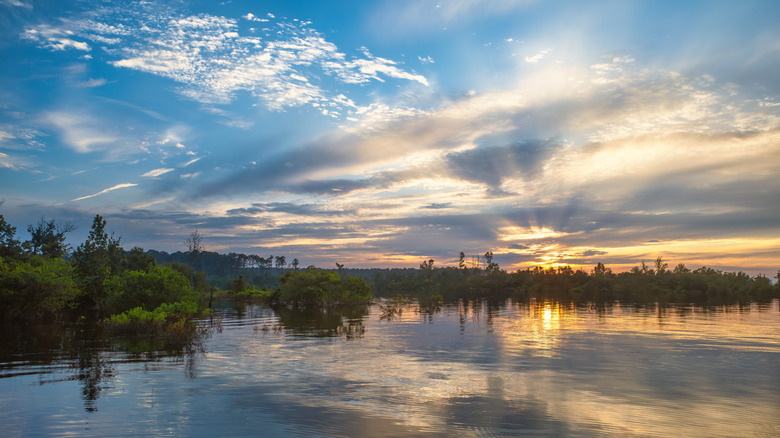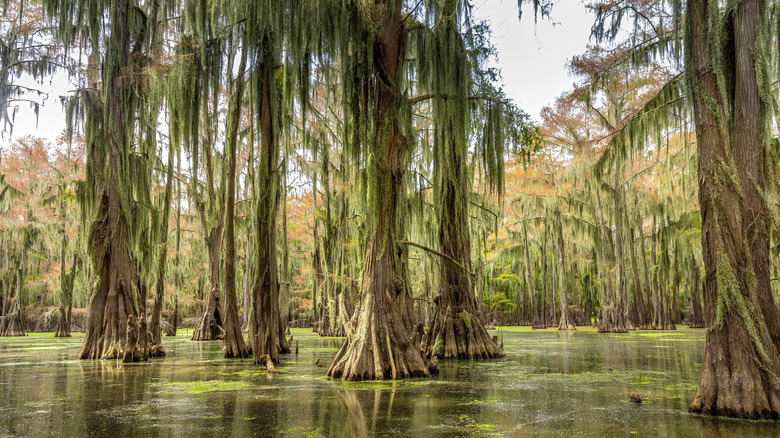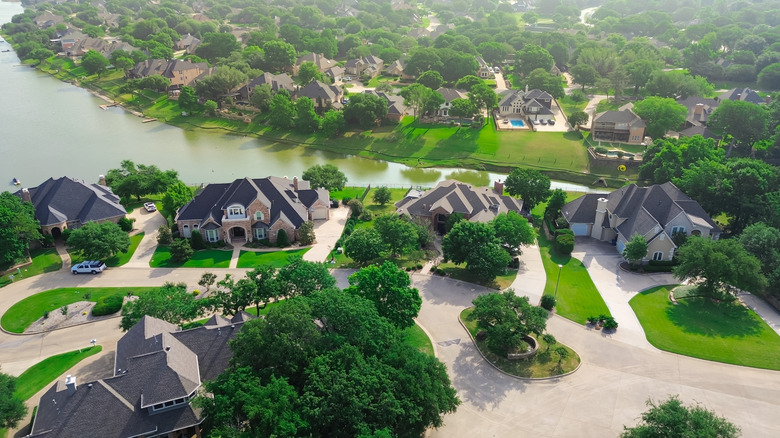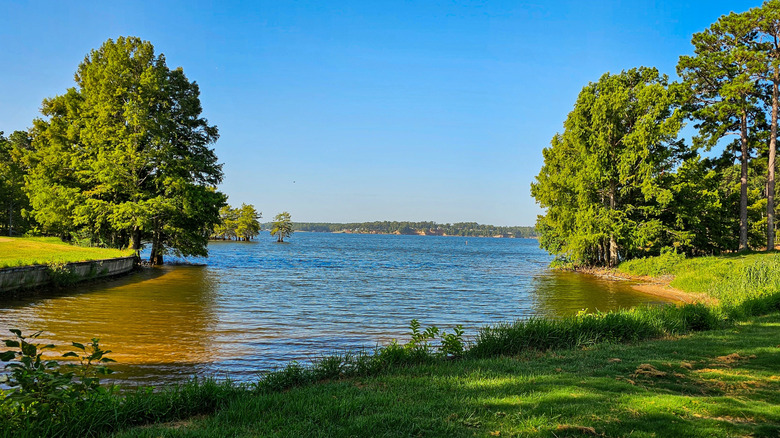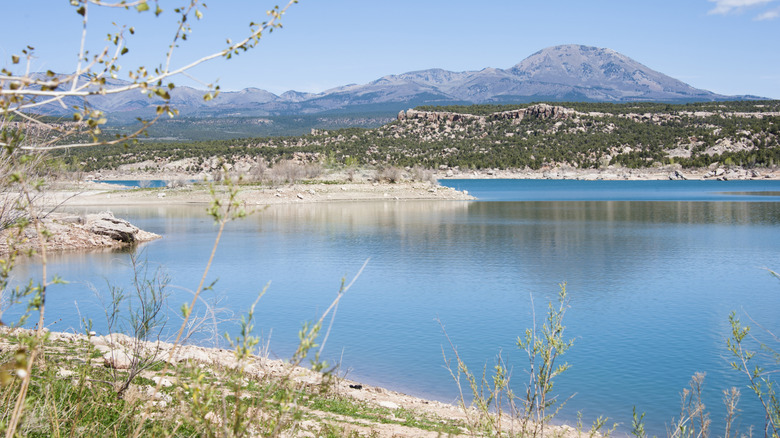Texas' Most Snake-Packed Lakes Aren't For The Faint Of Heart
Perhaps more than any other state, Texas is known for its stereotypes: cowboy hats and spurred boots, endless barbecue, guns and big oil, a fierce independent streak, and that weird blueberry in the tomato soup, Austin. And of course, everything is bigger in Texas, right? If you're talking about the quantity of snake species, that's 100% true, especially in its lakes. Texas' lakes rank among the most snake-infested lakes in the United States.
In fact, Texas has more snake species than any other state, at 68. That's 13 more than the next most snake-filled state, Mississippi, at 55. If we break apart Texas' snake species into subspecies, the number climbs to 96. Of those, 14 are venomous, and depending on the source, either nine or 10 are rattlesnakes. This disagreement is to be expected, as snakes don't really like people all that much. They'll slither, slink, and slip away into sights unseen to stay way away from bumbling bipeds. This is good for us humans, because otherwise we might all be walking around with fang-shaped puncture wounds on our feet, shins, and calves, especially in Texas and its seriously snake-flush rivers and lakes.
It might seem strange to associate stereotypical Texan deserts with dangerous, snake-filled waters. But, Texas actually has 196 lakes and about 80,000 miles of rivers and streams. Those waters contain critters that make good meals for snakes. And since all snakes can swim at least decently, water is no safe place from them. Even so, some lakes stand out as snake hotspots: Caddo Lake, Lake Texoma, Lewisville Lake, Toledo Bend Reservoir, and perhaps the most serpent-infested one of them all, the innocently-named Lake Sweetwater.
Caddo Lake is a swampy snake haven
Caddo Lake is more of a big swamp than a lake. Located at the eastern border of Texas and a mere 30 minutes from the closest city, Shreveport, Caddo Lake is split right down the middle between Texas and Louisiana. But nature knows no human boundaries, especially snakes. The 26,810-acre Caddo Lake is an overflowing snake pit that a whole 32 snake species call home (that have been spotted, at least) — that's almost half of all of Texas' snake species. Most notably for safety, this includes the northern cottonmouth, timber rattlesnake, and pygmy rattlesnake, all of which are venomous.
Even so, all these snakes don't seem to deter people from visiting Caddo Lake, the centerpiece of "gothic natural beauty" at the heart of Caddo Lake State Park and Caddo Lake National Wildlife Refuge. Both locations sit on the Texas side of Caddo Lake and offer pretty much every outdoor activity you could want. The state park has loads of water-based activities, including fishing and canoeing, plus a suite of campsites that includes RV hookups. There's also a handful of trails and loops that are perfect for bird, reptile, and amphibian watching — including watching out for snakes. The wildlife refuge similarly offers hiking, horseback riding, biking, boating, plus hunting within specific date ranges. But no matter what you do if you visit, be sure to keep one eye on the ground or water, because you never know where a snake might be slithering or swimming. If you see one, give it a wide berth and do not engage it unless you're begging for pain or a trip to the hospital.
Lake Texoma is teeming with snakes
While Caddo Lake sits along Texas' eastern border, Lake Texoma sits along its northern border, over 90 minutes from Dallas. As the lake's very on-the-nose portmanteau implies, part of it's in Texas and the other in Oklahoma, although the lion's share rests in Oklahoma. The 89,000-acre lake is the twelfth largest lake in the U.S. and such a monstrous mecca for nature lovers that it garners 6 million visitors per year. This is true even though it's absolutely teeming with snakes (and also alligators, for extra fun). On the non-venomous side, we've got species like the relatively harmless western ribbon snake and glossy snake. On the other hand, there's the venomous copperhead (responsible for more snake bites than any other U.S. snake, at 39%), western diamondback rattlesnake, pygmy rattlesnake, Texas coral snake (with venom 20 times more toxic than a rattlesnake), and semiaquatic cottonmouth (aka, water moccasin).
But indeed, folks definitely don't stay away from Lake Texoma, despite the fact that approximately 7,000 people are bitten by snakes in the U.S. each year. This is probably because the "Playground of the Southwest," as the lake is called, is just too appealing. Lake Texoma has so much stuff to do on both sides of the border that it's practically a massive vacation getaway spot. We don't just mean hiking, camping, horseback riding, or tossing a line into the water to snag a fish — but we do mean those, too. We're talking full-on cruises, resorts, wineries, golf courses, even six entire casinos, like West Bay Casino and Resort. And because of its size, Texoma is ringed in tourist towns like Fink on its Texas side. Just don't get so wrapped up in the fun that you step on a snake along the way.
Loads of snakes call Lewisville Lake home
Perhaps best known as "that lake that looks like a maple leaf," Lewisville Lake is closer to a metropolis than any other lake on our list — Dallas, about 30 miles away. This means that as many suburbs and neighborhoods surround it as it is parks and golf courses. Nonetheless, the snakes that call it home don't care too much about people hitting little balls with big sticks. Non-venomous snakes like the yellow-bellied racer, western coachwhip, speckled kingsnake, broad-banded watersnake, and diamondback watersnake live in Lewisville Lake and are pretty harmless. Snakes like the venomous western cottonmouths and our old friend, the very bitey copperhead, however? They're not very harmless.
As we've alluded, it's best to think of Lewisville Lake as a regional hangout spot for residents. Thinking of the lake like a maple leaf, the negative space of the leaf sticks out into the water and is connected by one big network of bridges and roads. The camping and RV-focused Hidden Cove Park sits on the lake's eastern side near the sprawling Del Webb Retirement Community, which itself sits next to Frisco Lakes Golf Club, a private club for nearby residents. The cluster of Cottonwood Park, Sporting Complex, and Nature Trail sits across the water from Frisco, and in between sits Little Elm Bay, adjacent to a beach and park of the same name. All of Lewisville Lake is like this, around and around the exterior, filled with whatever activity locals and travelers want. But, coiled within it all are the snakes. Residents and visitors should both exercise caution, especially because the surroundings seem so non-wild — it's easy to let your guard down.
The Toledo Bend Reservoir plays host to numerous snake species
Toledo Bend Reservoir is another body of water along Texas' eastern border that has Shreveport, Louisiana, as its closest city, about 90 miles away. This means that Toledo Bend can also count Caddo Lake as its regional neighbor, about 100 miles away. But, while Caddo Lake is an au naturel swamp and nature preserve, Toledo Bend is a 100% manmade, massive 181,600-acre reservoir. Taking five years to finish, from 1964 to 1969, it's actually the single largest body of water in the entire American South (surface area-wise). But, with great water comes great quantities of snakes. On the non-venomous side, we've got the prairie kingsnake and ... that's it. On the venomous side, we've got the western pygmy rattlesnake, the timber rattlesnake (aka, canebrake rattlesnake), southern copperhead, cottonmouth, and the most toxic one of them all, the Texas coral snake.
Nonetheless, Toledo Bend Reservoir is too tempting a place to avoid. The Louisiana side of the lake is home to both South Toledo Bend State Park and North Toledo Bend State Park, but the Texas half is home to the absolutely enormous Sabine National Forest, named after the Sabine River that connects to the reservoir — take that, Louisiana. The 160,656-acre national forest runs along the entire western side of Toledo Bend Reservoir and offers the usual gamut of hiking, camping, fishing, wildlife watching, as well as multiple boat ramps and discrete recreational areas like Indian Mounds and Boles Field. But as always, remember that snakes can cozy up next to your campsite as easily as they could slide against your leg if you go for a swim. Take care and watch out.
Lake Sweetwater is absolutely infested with venomous snakes
Finally, we come to the innocently-named Lake Sweetwater next to the town of the same name, about 45 minutes west of Abilene in central-west Texas. Lake Sweetwater stands out not for its modest, 630-acre size, nor because it's actually a manmade reservoir built way back in 1929. It stands out because the lake and the entire Sweetwater area play host to about 25,000 people every March who participate in the World's Largest Rattlesnake Roundup. Established in 1958 to protect ranchers from rattlesnakes — especially western diamondbacks — and hosted by the Sweetwater Jaycees social club, this is a multi-day, festival-like event. There are gun shows, knife shows, cook-offs, and yes, the massacre of as many snakes as possible. There are even awards for the most pounds of snakes killed and the longest individual snake killed. Welcome to the true Texan solution to dealing with vermin.
But all such organized slaughter amounts to mere catharsis, as the snakes never truly go away. Aside from the venomous western diamondbacks, Lake Sweetwater is home to copperheads (Texan broad-banded copperheads and eastern copperheads), cottonmouths (our favorite water-loving water moccasins), the Texas coral snake, and other rattlesnakes of various types. All of these snakes can kill you. But if you're really into boating or fishing (and hand-waiving danger), largemouth bass, catfish, crappie, and sunfish await. There's also a park, Lake Sweetwater Municipal Park, that has regular camping and 32 RV spots. There's even a nearby 18-hole golf course at the northwest corner of the lake. If you do wander around the lake a bit, stay on the trails. But if you get bit, there's always vengeance to be found at the World's Largest Rattlesnake Roundup. If you live, that is.
